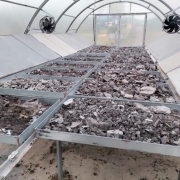Greenhouse Solar Dryers: A Cost-Effective Solution to Ensure Safe Application of Faecal Sludge in Agriculture
Non-judicious and long-term application of chemical fertilizers not only deteriorate soil quality but also contributes to climate change effects due to the emission of greenhouse gases during the production and application of these fertilizers. On the other hand, there is an urgent need to look for alternative nutrient sources for food production to feed the growing population.
It is widely known that human excreta is rich in nutrients, specifically Nitrogen and Phosphorous. With the recent thrust on faecal sludge treatment and safely managed sanitation, there is an opportunity to use human excreta as a nutrient source. However, there are concerns of health risks due to the presence of pathogens in faeces. The main cause of concern is the soil-transmitted helminth infections as these are highly resistant to treatment and viable for several years.
In this context, this study was conducted in 4 locations (FSTPs – Faecal sludge treatment plants) of India – Angul, Dhenkanal, Karunguzhi and Devanahalli with the main objective to evaluate the efficiency of polycarbonate-based greenhouse solar dryers in reducing the Helminths eggs in the final treated sludges. Greenhouse solar dryers (GHSD) use passive drying to help increase the temperature and decrease humidity to ensure pathogen kill as well as faster drying.
Scenarios studied under the project:
Following were the assumptions made for the study,
- Increased temperature and decreased relative humidity inside the GHSD chamber will help in reducing the sludge drying time.
- Longer exposure of sludge to higher temperature (>50°C) will inactivate Helminths eggs.
GHSD is the polycarbonate sheet installed over the drying beds. This has a parabolic shape to resist wind and to induce greenhouse effect inside the drier. This greenhouse effect inside the drying chamber helps removing the moisture laden air and the moisture content from the drying product (Figure 2).
Solar pasteurisation unit (SPU) follows the same working principle and the structure of the GHSD. However, the height of the roof is less compared to the GHSD. The dried sludge from the GHSD is placed in the SPU. Due to reduced height of the chamber and low moisture content of the sludge, SPU can reach to a higher temperature of more than 60 degrees Celsius which will help eliminating the pathogens (Figure 3).
Galvanised (GI) sheet is one of the most used roofing materials over the sludge drying beds. These are galvanized metals made of thin sheets, coated with zinc. The main purpose of these sheets is to protect the drying beds from getting wet during rainy season.
Below mentioned scenarios were studied under the project,
- Greenhouse solar dryer (GHSD): Angul and Devanahalli FSTP
- Galvanised (GI) sheet + Solar Pasteurisation Unit (SPU): Dhenkanal FSTP
- GI sheet and GHSD: Karunguzhi FSTP.



